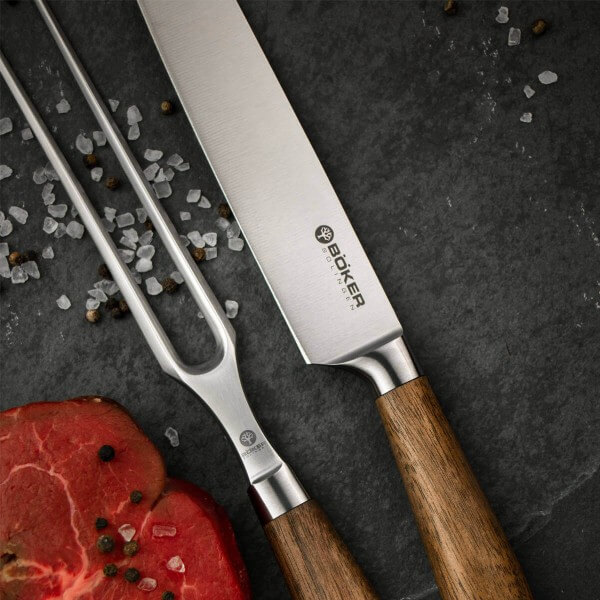The knife has been an essential universal tool for more than 2.4 million years. Knives are available in a wide variety of shapes and designs for almost any purpose. As a tool, kitchen implement, decorative object or collector's item – people value the advantages of these sharp tools in every kitchen. The construction possibilities for a kitchen knife are almost as varied as the possible uses – from cutting fresh bread to carving a beef tenderloin or filleting fresh fish.
At the Boker Manufactory, we use three different blade and handle joint designs, depending on the knife series. Each design has its own tradition and purpose, and offers different advantages in terms of production, handling and use. Despite all differences, these designs of Boker kitchen knives have one thing in common - they are all excellent and superior kitchen knives that you will never want to put down. Depending on your individual and personal preferences in terms of design, weight, ergonomics and balance, you are sure to find the right knife in our collection.

The Forged Bolster
European kitchen knives are mainly used to cut with pressure. The die-forged bolster offers a few distinct advantages. For this cutting technique, the index finger or middle finger presses down on the end of the blade. Thanks to its three dimensional shape, the bolster serves as a comfortable pressure point. At the same time, its weight supports the cutting movement when the blade moves forward. The knives in our Boker Core series are die-forged with a bolster. Die-forging is a technique with roots in the early days of industrialization. First, a roughly shaped piece is cut off from the raw material. This piece is brought to a red heat and hammered into shape inside a massive form consisting of two halves, top and bottom. This process is also called drop forging. The bottom die serves as a counter surface. The die dropping down onto the blade is affixed to a drop hammer weighing two tons. The resulting blade blank needs to be soft-annealed before the blanks are deburred, which means that the excess material created during the forging process is removed. The blank is calibrated again on a knuckle joint press with 800 tons of pressing force. This process is particularly suitable for sharply contoured blade profiles. The bolster remains a technical challenge, even and especially after forging. A grinder now shapes the knife's fine contour from the rough blank. The complex three-dimensional and conical structure of the bolster requires the grinder's full experience and concentration. Careless handling can cause unsightly dents or notches at all junctions of the blade and handle.

The Full Tang
The full tang is the simplest and most robust solution. The concept comes from outdoor knives, and is most often used for knives that need to be particularly sturdy and withstand even abuse and improper usage, such as prying or chopping. The full tang follows the entire handle shape; the scales are riveted on from both sides. Then, the handle scales are fitted to the tang on a belt sander and also rounded so that they offer a pleasant and secure grip. The knives in our Boker Saga series feature a full tang.

The Push Tang
As much as needed, as little as possible. The push tang is the lightest of the listed joints. Its philosophy is "as much as needed, as little as possible". The actual tang is narrower than the ricasso that goes on into the handle. The tang runs through about a third of the length of the handle. Here, it is held by a single stainless steel rivet. The wood at the front end of the handle is protected by a finely satinized ferrule. Fitting the ferrule is particularly difficult, because its spot on the handle is both conical and oval. This means that it doesn't have a regular geometric shape. This construction follows the Japanese tradition and we use it for our series Boker Damascus Olive and Boker Damascus Black. In Japanese cooking, most cuts are pulled. With this technique, the blade is easier to control if the handle is lighter compared to the blade. If flexural forces came into play during the cutting process – though those are negligible when working with food – they would be happening in the strongest spot of this connection

